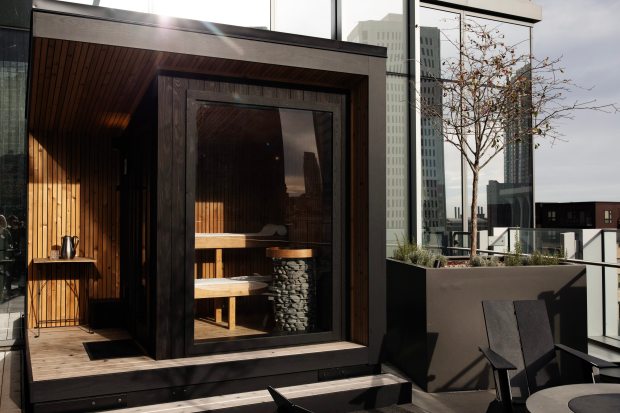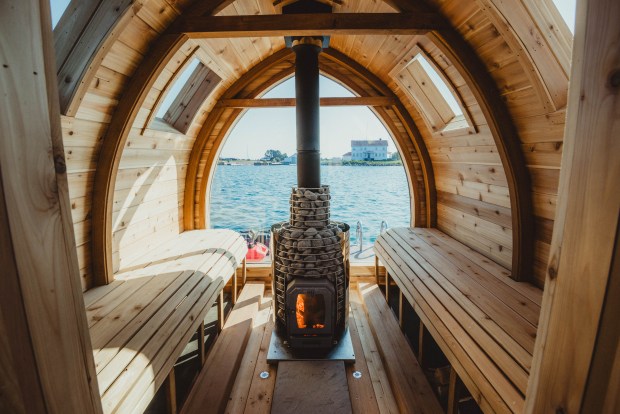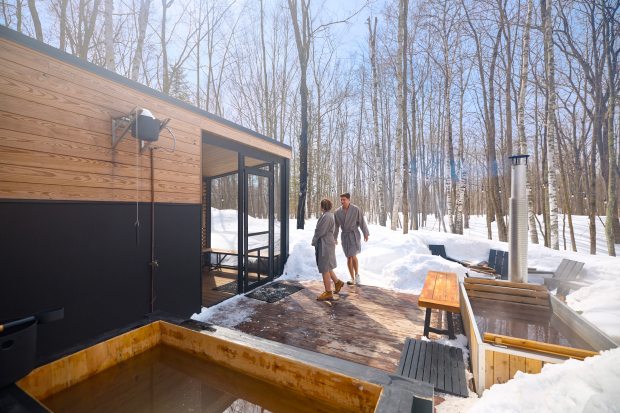Around this time of year in the Midwest, a visit to a steamy sauna can be a perfect way to counter gray skies and chilly temps. But instead of heading to the gym or a spa, you may want to consider a visit to Minnesota.
Long before saunas became an essential part of those hotel gyms, fitness clubs and day spas, the original versions in Minnesota were built by the thousands of Scandinavian people who settled there in the late 1800s and early 1900s. The wooden structures were erected on farmland and became a part of the community, a gathering place for socializing and a connection to the culture and traditions of the homeland.
Many farmers established saunas as part of their property and the facilities are also part of Finnish mythology. They were included in rituals such as a pre-marriage cleansing of the bride and groom and a part of childbirth. Their health benefits have long been touted. Sauna users would be slapped with birch branches to exfoliate the skin and increase respiratory and cardiovascular functions.
Temperatures in the structures generally hover between 180 and 200 degrees. After the heat builds up, users often take a cool plunge in icy waters.
“Saunas make you feel alive and refreshed,” said Heidi Barberg, trustee and past president of the Cokato Finnish American Historical Society. “(A sauna) gives you a warm feeling that can help you sleep better, cleanses your pores, flushes body toxins out, and rinses off the toxins.”
Barberg should know. She uses a sauna built by her great grandfather in 1881.
Today, travelers and spa enthusiasts can experience this tradition firsthand during a visit to Minnesota. And you no longer need to know someone with their own sauna because several public facilities have opened. If you visit the state, especially during winter, you’re sure to see small chimneys rising from wooden shacks along the landscape.
Essential sauna experiences
While many sauna lovers now enjoy the steam in the privacy of their own homes, Minnesota now has public commercial saunas. They’re found throughout the state, but especially in the north, where Finnish communities remain.
“The best public saunas are the ones you find in Finnish communities,” Barberg said. “If you get invited to one of those, you will have the best introduction of having a sauna.”
Several of the outfitters that run guided tours to the remote Boundary Waters Canoe Area Wilderness also have saunas at their campgrounds, where you can unwind after a long day of paddling.
Some of the popular public saunas in Minnesota include the Silvae Spiritus in Finlayson, the Cedar and Stone Floating Sauna in Duluth and Thermaculture in Minneapolis.
The Barberg-Selvälä-Salmonson Sauna, which is no longer operational, is still worth a visit. Named for the three families who settled the area, the Barberg-Selvälä-Salmonson Sauna is a historic Finnish smoke sauna in Cokato Township. It’s believed to be the oldest in the nation. Built in 1868, the savusauna, or “smoke sauna,” is a wooden building powered by a fire with heated rocks. Spagoers could cool off using cold water or, during much of the year, fresh snow. Now part of the Cokato Finnish American Historical Society, the ax-hewn log building shows what the earliest saunas in the state looked like through the 1930s.
Ely Steam Sauna
The oldest public sauna still in operation in the state is the Ely Steam Sauna, which has been running since 1915 in the city of Ely. This place is as authentic as it gets, shy of an invite to a Minnesotan’s backyard sauna. For public steams, there are men’s and women’s options, as well as private saunas. Kids can also participate. Sessions run from $11 for 90 minutes for public saunas and include soap and towels plus access to the spa’s showers and cool down area. Private saunas can accommodate up to five people.
Four Seasons Minneapolis

The spa at the Four Seasons Minneapolis has taken the sauna tradition and created a guided experience similar to the Nordic spas elsewhere in the state. Created in collaboration with Cedar and Stone Nordic Sauna, a spa attendant uses different aromas within the sauna and, when you’re ready to cool off, can direct you to the cold water bucket shower. Best of all, the patio where the sauna sits overlooks the city’s North Loop neighborhood. The year-round experience can be booked in advance and is $175 for 75 minutes. There’s also a weekly social sauna hour where guests can reserve seats instead of the full sauna.
Sauna Camp
As the name implies, Sauna Camp keeps the camp vibes going all winter. The facility in Excelsior has a social environment made up of eight barrel-shaped saunas that can each accommodate 20 people. After stints in the heat, visitors can take a cold plunge in Lake Minnewashta. Kids age 6 and older are allowed at the camp. A single-day pass for a two-hour visit costs $49.
Sisu and Löyly
Named for the Finnish words for the uniquely Scandinavian toughness and the spirit released from the steam, Sisu+ Löyly is set on the shores of Lake Superior in Grand Marais, in the far northeast of the state. Visitors can watch the water from inside the saunas or relax outside by the bonfire. The company also operates seasonal floating and mobile spas, including one in Skyport Lodge during summer and fall and another at a winery open during the winter and spring. The former is the first floating sauna open to the public in the United States. Guests can borrow robes, water bottles, sandals and towels for a fee. The signature sauna experience is $79 for 90 minutes and is offered year-round.

Tips for visitors
Each sauna has its own set of rules and recommendations. Adult supervision is recommended for kids under 10. Some facilities are separated by gender while others are mixed. The maximum time recommended to stay in a sauna is 90 minutes, but you can take breaks during this time to cool off or do a cold plunge.
While nudity is commonplace at saunas abroad, most of the aforementioned saunas require clothing, specifically a swimsuit, for all guests. It’s a good idea to bring slip-on shoes that can be left outside the sauna plus a bathrobe to throw on once you’re done. Some swear by neoprene booties that can be worn going to and from the sauna and the lake. Bring only what’s essential as most facilities don’t have much in the way of storage.
Alcohol is not allowed in the saunas. Instead, bring your own bottle of water and stay hydrated throughout the experience. Many of the saunas offer warm drinks to enjoy after your steam.
Most importantly, take time to disconnect, unwind and enjoy your surroundings.
Caroline Eubanks is a freelancer.





